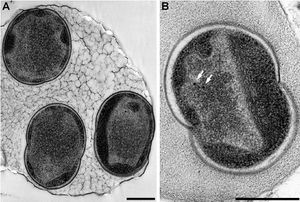Limnohabitans (genus)
Classification
Domain: Bacteria
Phylum: Proteobacteria
Class: Betaproteobacteria
Order: Burkholderiales
Family: Comamonadaceae
Genus: Limnohabitans
Description
The genus Limnohabitans belongs to the class Betaproteobacteria, which is well known for its morphological and physiological diversity, as well as its high abundance compared to other bacterial groups in freshwater lakes. Due to its abundance and easy ability to culture, Betaproteobacteria best-studied group in freshwater lakes.
Betaproteobacteria has been divided into seven lineages - betI, betII, betIII, betIV, betV, betVI, and betVII. Members of the genus Limnohabitans are represented in the betI lineage, which have recently been isolated in pure culture and accurately described. There are four Limnohabitans species within the betI lineage, as follows:
Limnohabitans curvus - chemoorgantroph, aerobe, and facultative anaerobe that can assimilate glucose and other small organic acids (not including amino acids)
Limnohabitans planktonicus
Limnohabitans parvus
Ecology and Significance
The Betaproteobacteria in freshwater lakes are fast-growing, nutrient-dependent, and have a size-dependent vulnerability to grazing pressure. The betI and betII lineages are the most abundant and widely distributed lineages in freshwater ecosystems. Recent isolations of various members of genus Limnohabitans, which belong to the lineage betI, have assisted in the understanding of freshwater bacterial roles in their ecosystems.
Morphology and Genome Structure
Limnohabitans have varying morphologies and structures. Isolated strains have been described as coccoid, ovoid, bacillus (curved and short-rod) or solenoid. Cell sizes range from 0.4 um in diameter of cocci and up to 5 um in length of curved bacilli.
Metabolism
Growth of L. parvus and L. panktonicus on algal exudates as a sole dissolved organic carbon source (DOC) has recently been confirmed. The photolysis of this dissolved organic matter creates products that are suspected to be an important additional substrate source for Limnohabitan bacteria.
References
[1] Golyshin, Peter N. “Genome Sequence Completed of Alcanivorax borkumensis, a Hydrocarbon-degrading Bacterium That Plays a Global Role in Oil Removal from Marine Systems.” 3 (2003): 215-20. Print.
Figures
[1F]
[1] [2F] [2] [3F] [3] [4F] [4] [5F] [Original Figure. Author: Pawan Dhaliwal] [6F]
http://microbewiki.kenyon.edu/index.php/File:Lorenzo.gif
[7F] [5]
Author
Page authored by Taylor Wagner, student of Prof. Katherine Mcmahon at University of Wisconsin - Madison.

